Ask the Pros: Split shots
Mike Veitch
Mike is a longtime photo and video pro based on the island of Bali where he conducts underwater photography workshops and runs photo focused expeditions throughout Indonesia through the Underwater Tribe.
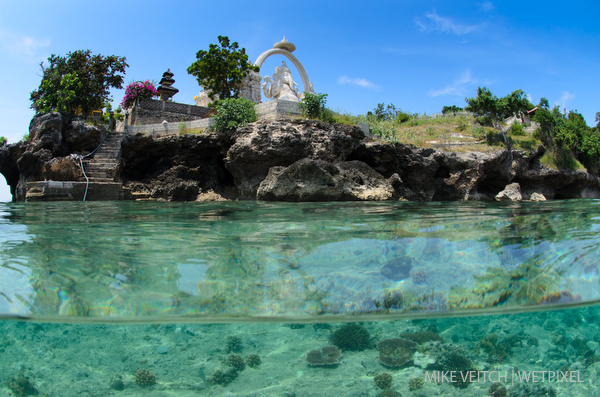
What is your favorite lens for shooting over/under images? Please specify whether you are shooting full frame or cropped sensor. What size dome port do you use?
I prefer the Nikkor 10.5mm, I shoot with a crop sensor Nikon SLR. The port that I use is an 8 inch dome but of course I would prefer a larger one!
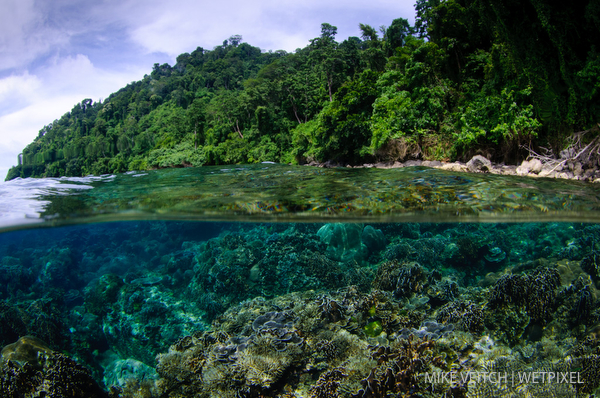
How do you expose the images? Do you use tools in post to adjust either underwater or above water exposures?
Typically I will choose a fairly high fstop to achieve a good DOF, I start with f11. Then I meter the below water portion and dial in my shutter speed until I get to 0 on the light meter. This gets my underwater portion in the right ball park and will overexpose my above water portion but I then take a test shot to see it looks like anyway. I will then adjust my shutter speed accordingly to achieve as close to proper exposure on the below water as I can (if the scene is close enough I may experiment with strobes). I don’t mind the above water portion being blown out (within reason of course) as I can then use the gradient tool in Lightroom to bring it back down again.

How do you shoot splits of fast moving animals?
Are jellyfish considered fast moving?
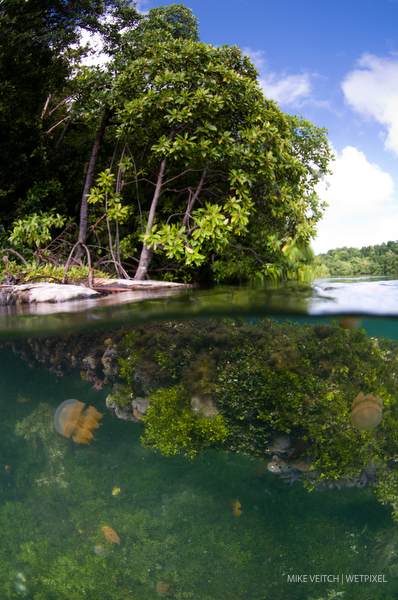
What makes for a great dive site for shooting over/unders? (Shallow reefs, sun angles etc.)
Plenty of hard corals in very shallow water. Living in Indonesia I have an abundance of these and usually can find them in clear water.
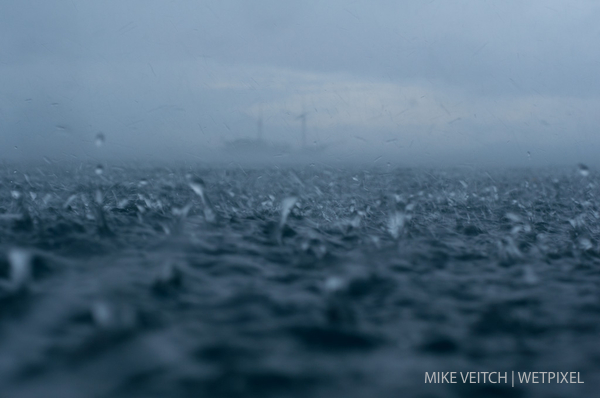
Why do you think over/unders are so popular with people? Do your split level shots sell well? In turn, do you set out to shoot them specifically for this?
I think its the “wow” factor that impresses non divers. Most people look at a split shot and think “Wow, how the heck did they do that!?” I have actually found that splits do not sell well, even though I thought they would. I had this discussion with a fellow underwater photographer just this last week who sells a lot of imagery via Royalty Free sites. I thought that his outstanding collection of split shots would be his biggest selling images on the stock photography sites but he in fact informed me that they rarely ever sell! I have to admit I was surprised by that as they are so visually stunning, however, they don’t seem to sell that well with the non underwater mainstream media. However, with dive media I find that I can always incorporate a beautiful over/under photo with a location article.
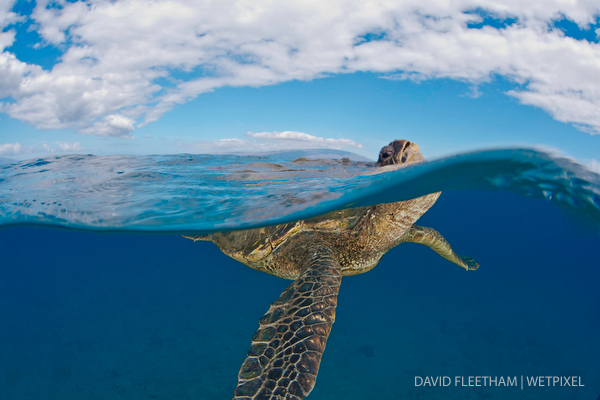
David Fleetham
David Fleetham is one of the most published underwater photographers in the world. He began diving and photographing underwater in 1976 and his photograph of a sandbar shark appeared is the only underwater photograph to feature on the cover of LIFE.
What is your favorite lens for shooting over/under images? Please specify whether you are shooting full frame or cropped sensor. What size dome port do you use?
I am shooting a Canon 5D Mark III in an Ikelite housing with Ikelite’s 8 inch dome for splits, and a Sigma 15mm full frame fisheye lens.
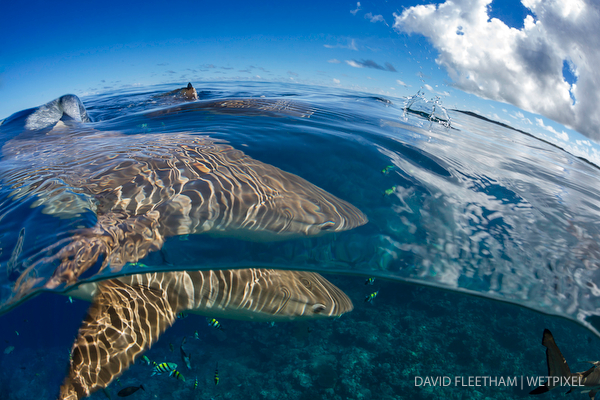
How do you expose the images? Do you use tools in post to adjust either underwater or above water exposures?
I shoot on Aperture priority keeping my f-stop to @ least F 11 and if I can F-16 or smaller, and generally underexposed by one full stop. With the newer cameras I am more likely to turn up my ISO to accomplish this. In years past this would create noise in the darker areas but with the newer technology it looks amazing.
For me, no RAW file goes out the door without first going through Lightroom and then inevitably Photoshop and splits are certainly no exception.
How do you shoot splits of fast moving animals?
With my fingers crossed. If I’m shooting fast-moving animals I generally first try to get a decent image from the surface that is not a split. If I’m lucky enough to have a lot of time with my subject I will lift the housing out of the water and try some splits, but only after I know I have some good images in the can.
What makes for a great dive site for shooting over/unders? (Shallow reefs, sun angles etc.)
The shallow reef with the sun coming over my shoulders illuminating the marine life and the picture perfect island is of course what we all look for, along with the bikini-clad snorkeler in the upper left corner swimming to the right. I shoot this when I can but I am not against shooting the perfect reef even though it doesn’t have the perfect background and then adding the island later. Calm surface conditions and if it’s possible to get your feet on the bottom, of course without damaging any marine life, makes a huge difference in being able to take your time to get what your minds eye sees.
For the water drop problem I will take the fine Novus dome port polish or shampoo or even mask defog, rub it on the dome with my fingers and let it dry until it is opaque. I will then rub it off with a soft cloth until it is clear. Nothing seems to last very long but this will give you a half hour or so if you don’t dip the housing very much.
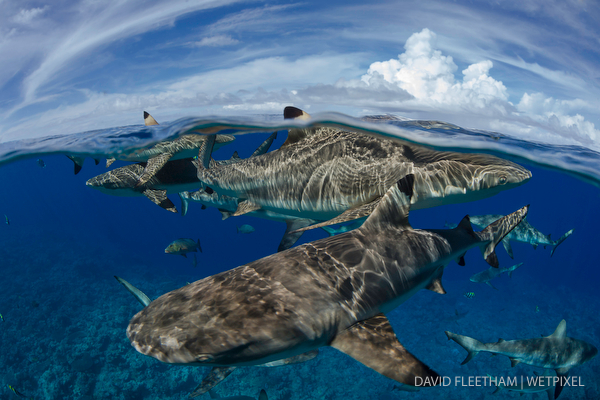
Why do you think over/unders are so popular with people? Do your split level shots sell well? In turn, do you set out to shoot them specifically for this?
Good, half above, and half below images are difficult to shoot and are therefore few and far between. The coming of digital cameras has of course made this quite a bit easier. In the past you would do your best with the 36 shots that you had. Now you are more than likely to nail it with the 236 shots that you get to shoot. When the water is jumping up and down on your dome port just keep pulling that trigger.
Eiko Jones
Whether exploring the ocean or fresh water bodies, Eiko has developed a dramatic style of photography in which he celebrates the corners of our world seldom seen.
What is your favorite lens for shooting over/under images? Please specify whether you are shooting full frame or cropped sensor. What size dome port do you use?
Tokina 10-17mm, I shoot this on a Full frame in the 13-17mm range with an Aqautica 4” glass dome. Yes I know, A bit weird but I like the versatility it gives me in my environment of often fast moving shallow water. I like the way the water transition looks. It is not so perfect as with the mega domes.
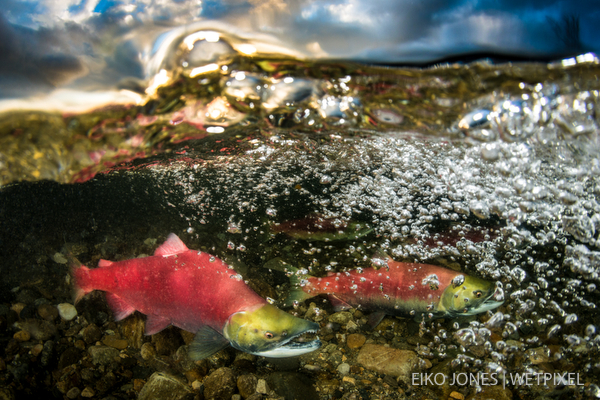
How do you expose the images? Do you use tools in post to adjust either underwater or above water exposures?
I generally expose properly for the underwater scene and get as close as I can above water. Then I add grad filters in post processing if I need to darken the upper portion.
How do you shoot splits of fast moving animals?
By getting myself in as comfortable position as I can and shooting lots. This can be challenging if in deep water with salmon for example. Sometimes I pre focus on the virtual image distance underwater that I think will be appropriate. But IO prefer to always look through the viewfinder and use single spot focusing.

What makes for a great dive site for shooting over/unders? (Shallow reefs, sun angles etc.)
Shallow is good as you can often rest on the sand or gravel allowing for steady holding of the camera. I personally like split scenes with vegetation close in above the waters surface. I particularly like shooting splits into a rising/ setting sun. ( even before I saw Matt Smith’s cool work!)
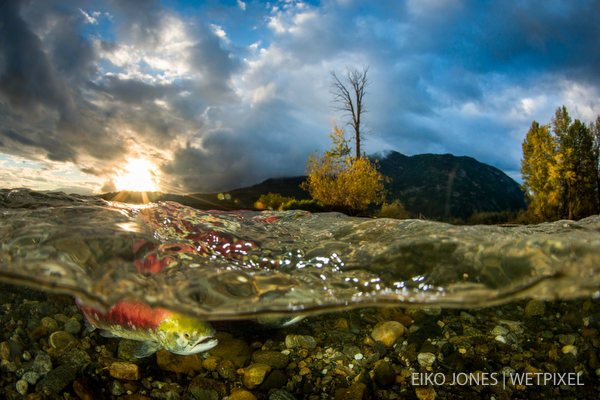
Why do you think over/unders are so popular with people? Do your split level shots sell well? In turn, do you set out to shoot them specifically for this?
I think they are popular and sell well with the general public because they can visualize themselves in the scene. As compared to a scene taken at 80 feet which a non diver has no reference level. I purposefully shoot a lot of splits, especially in river settings.
Page 1: David Doubilet, Franco Banfi, Cristian Dimitrius, Allison Vitsky Sallmon and Andy Sallmon.
Page 2: Matt Smith, Douglas Seifert.
Page 3: Mike Veitch, David Fleetham, Eiko Jones.
Page 4: Viktor Lyagushkin, David Salvatori, Becky Kagan Schott.
Page 5: Rico Besserdich, Julian Cohen, Berkley White.